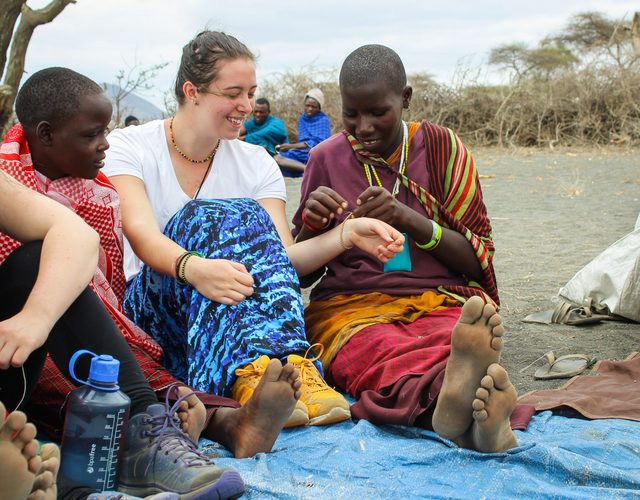apologize for the long lull in communications; the internet here has been extremely unreliable for the past couple of weeks, so this post is a long one!
Some updates from last post:
We’re getting (dare I say?) a lot better at Swahili, although we still mess up here and there. The other day, I accidentally said that Mercedes knows how to bake trees (kupika mti) rather than that she knows how to bake bread (kupika mkati). It always brings huge smiles to Faith and Mama Faith’s faces, so our mistakes are always in good fun.
We have also now successfully taken the daladala to Arusha a couple times without guidance and survived! Now that we’ve expanded our vocabulary to include “I don’t want it,” and “stop,” we are much better at deterring street vendors. We’ve also realized that splitting into small groups is the best way to travel in Arusha.
We spent the weekend of September 8-10 at Engikaret, a Maasai village…
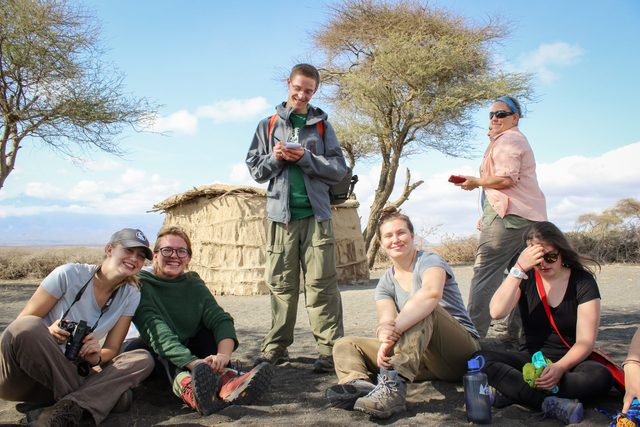
Upon arrival to Engikaret, the first thing we heard was the beautiful blend of singing voices in Maa (the language of the Maasai), welcoming us to their home. When greeting elders, it is respectful to bow your head and allow the elder to put their hand on your head while saying the greeting. We lined up to greet everyone, using 2 of the 3 Maasai words we knew–for future reference, just know that you respond to “supai” with “ipa,” and “takwenya” with “iko.” Having only learned those words a few minutes before arriving, we all fumbled with our responses during the greeting period. When we did get a response right, the elders we were greeting seemed impressed and said “Ohhhh,” then tried to test our knowledge with a second greeting. Here’s how it went:
Elder: Supai.
Me: Ipa.
Elder: Ohhhhh, takwenya.
Me: Iko.
Elder: Ohhhh.
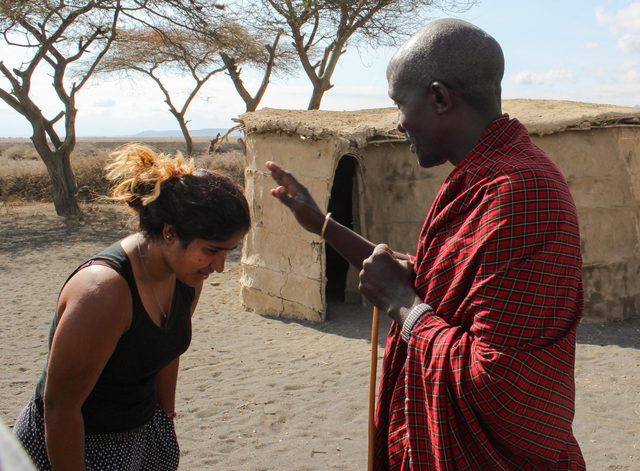
Mercedes, greeting an elder
After greetings, we were shown around the bomas and homes. Bomas are big living spaces, separated from the wild with barriers made of acacia bushes, whose thorns we’ve all experienced the wrath of. Each boma is traditionally built around one acacia tree, marking the center of the boma. When that tree dies, the people of that boma move and build a new one. Each house is built by one woman–the wife of the warrior the boma is centered around. It takes about 3 months to build and is made of mud, sticks, and cattle manure.
After a boma tour, we went on a long hike to collect firewood. During this hike, we experienced the most breathtaking sunset I’d ever seen, accompanied with young children herding goats, acacia thorns grabbing our legs, and stray dogs chasing rabbits. I wish I could show you what it looked like, but I’m sorry to say that I didn’t bring a camera or phone with me that afternoon… The Maasai use acacia branches as firewood, too! It makes sense– the stuff is so dry, I could see it catching very easily. While all of us are trooping around in our thick-soled hiking boots, trying to avoid acacia thorns, the Maasai had curved sandals made of tires and at times, walked straight through the acacia.. I’m definitely impressed–they must have feet of steel.
That night, we sat around the acacia bonfire and had a long talk with the elders, exchanging questions about each other’s cultures and families. This discussion required two translators: one to go from English to Swahili, and another to go from Swahili to Maa (and vise versa). Though we couldn’t understand what was being said 3/4 of the time, it was really fun hearing the back-and-forth of Swahili and Maa and trying to pick out words we knew. The Maasai do not answer individually or as a group, rather, they all contribute their own thoughts, and the eldest gives the final compiled answer to the translator. As the fire crackled in front of us, we looked up and saw an astonishing milky way that eventually faded as a red, full moon rose in the sky. It’s so interesting seeing how different the stars are on this side of the earth.
The next day, everyone got up early to go on a sunrise hike. As we sat, shivering, in the grass, the sun began to rise from behind Mt. Kilimanjaro, it’s intense rays warming us immediately. While watching the sun’s light creep across the ground and hit Mt. Meru, Patrick, one of our guides pointed to a moving dot in the distance: a giraffe. Another dot soon joined that one and the pair made their way across the landscape, eventually crossing in front of Mt. Meru and Mt. Kilimanjaro. Obviously, we were all ecstatic at seeing our first wild giraffes–even though we knew we’d soon be seeing many on safari–so we ran halfway to the black dots until we could see the clear outlines of the giraffes against Mt. Meru. It was a pretty magical scene.
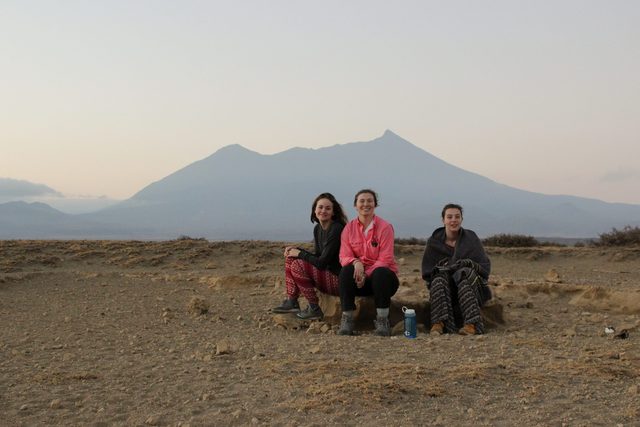
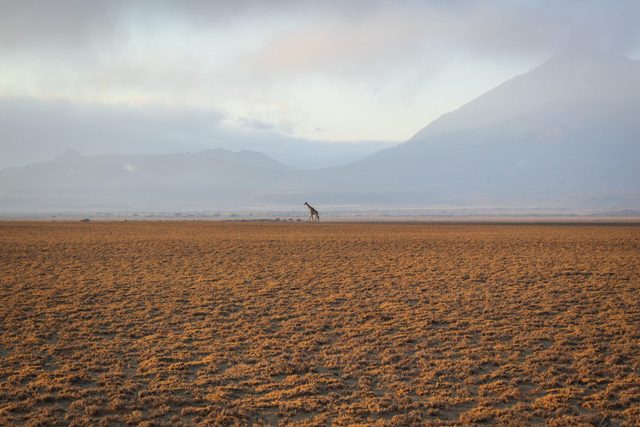
After a delicious breakfast, we set out to learn about medicinal herbs that the Maasai use. The various plants and trees we saw along the way had extremely diverse uses, from toothbrushing, to antibacterial properties, to eye-cleaning.

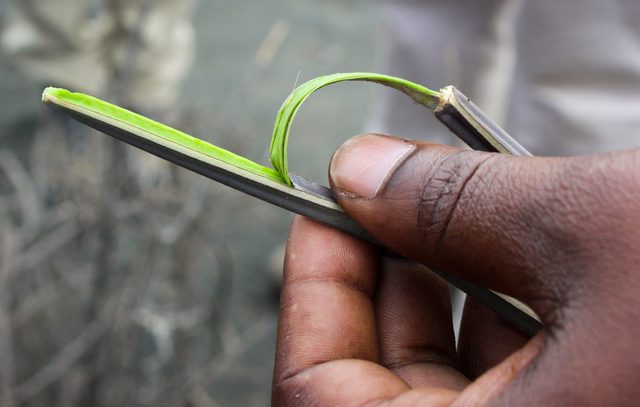
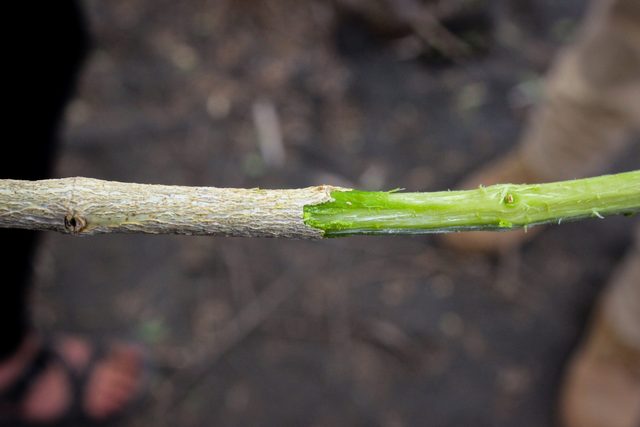
Plant used to brush teeth

Lindsay, taking notes on ethnobotany
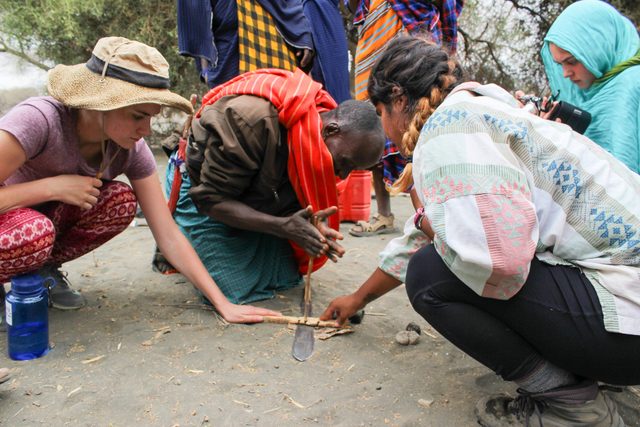
Students helping to start the fire
After the fire was started, the slaughtering of the goat began–death by suffocation. Then, the goat was skinned while a pot of water was boiled, and goat parts began getting eaten raw or being put in the pot. After about an hour, the stew was ready to drink and the parts of goat being roasted over a second fire were ready to eat. Traditionally, only Maasai men are allowed at the ceremony, but being non-Maasai, the gender difference didn’t matter, and we were all invited to help with each part of the preparation and were even offered roasted goat and stew.
That night, with only the milky way, the moon, and Walter’s (one of our guides) flashlight, we danced with the warriors. The only music was the sound of their voices, most of it being low hums, occasionally broken up with a lighter, higher melody. We weren’t sure how much of the dancing we were supposed to be participating in, but we got really into it and it became the highlight of the weekend for a lot of us! I don’t believe my writing can do this night justice– it’s something that can only be described by being experienced firsthand, but, I will try my best to describe what it was like. The first part of the dancing involved the warriors bouncing up and down and humming in a rhythmic way, and we eventually caught on to the pattern. Then, the circle of bobbing broke apart and we ended up on one side of the boma, with the warriors opposite us. The next dance had the warriors one by one running towards our group and jumping as high as they could into the air with a yell and landing with a resounding thud. A couple of us tried the same, running at them, yelling, and jumping, but none of us succeeded in getting as much height as they were able to. After that, we played a “game” of stealing people from each other’s sides. The warriors would run at us as a group and bring a couple of us to their side, and then we’d try to steal ourselves back or steal some of them. Another dance involved two little girls with white, flat collar-like necklaces balanced delicately on their shoulders. They moved in a circle opposite from each other, moving their shoulders to bob the necklaces up and down around their necks. The warriors would try to “scare” them by running at them and yelling, and it seemed like whoever’s necklace faltered or lost the rhythm first “lost.” After cycling through these couple of dances, the warriors asked us to sing something for them, and we all joined in on a very out of tune “Don’t Stop Believing.”
The next day, we walked to the up-and-coming “Woman’s Cultural Center,” a boma in construction, created for the purpose of allowing the women in the area to have their own source of income, as they are not themselves allowed to own animals. We sat with some Maasai women and learned about their beading techniques. The string they use for beading comes from old woven bags, and each bead color has it’s own significance– white represents milk, black represents their god (Ngai), light blue represents the sky, dark blue represents the ocean, green represents landscape (the trees and grass), red represents blood, yellow represents colostrum, and orange represents goat placenta. They had a quick technique down– putting beads on acacia thorns and then threading them through a braided string. As we beaded with them, we discussed any questions they had for us or that we had for them, and it was an interesting dynamic talking only with the women. Adorned with beaded necklaces, bracelets, and anklets, we got ready to leave, but not before all the mamas showed us the beautiful beadwork they had all created. After talking to the mamas and buying some bracelets and other beautiful beaded products, we said our goodbyes to everyone at Engikaret. We were definitely happy to escape the dust and have showers, but sad that we couldn’t spend more time talking to the people of Engikaret.
